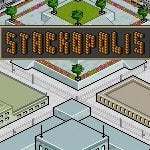- Wondering how to get Monopoly GO! free rolls? Well, you’ve come to the right place. In this guide, we provide you with a bunch of tips and tricks to get some free rolls for the hit new mobile game. We’ll …
Best Roblox Horror Games to Play Right Now – Updated Weekly
By Adele Wilson
Our Best Roblox Horror Games guide features the scariest and most creative experiences to play right now on the platform!The BEST Roblox Games of The Week – Games You Need To Play!
By Sho Roberts
Our feature shares our pick for the Best Roblox Games of the week! With our feature, we guarantee you'll find something new to play!Type Soul Clan Rarity Guide – All Legendary And Common Clans Listed!
By Nathan Ball
Wondering what your odds of rolling a particular Clan are? Wonder no more, with my handy Type Soul Clan Rarity guide.
Stackopolis Review
Finishing a construction job on a tight deadline can be a real challenge, but what if you had to assemble an entire building in seconds? That’s the challenge presented by Stackopolis, the classic flash game of tile-based construction from Bloc Media. And while the art style borrow heavily from Habbo Hotel, don’t expect any type of social interaction from this puzzling masterpiece. On the Stackopolis construction site, it’s all hotel and no Habbo.

Finishing a construction job on a tight deadline can be a real challenge, but what if you had to assemble an entire building in seconds? That’s the challenge presented by Stackopolis, the classic flash game of tile-based construction from Bloc Media. And while the art style borrow heavily from Habbo Hotel, don’t expect any type of social interaction from this puzzling masterpiece. On theStackopolis construction site, it’s all hotel and no Habbo.
At first glance Stackopolis may look like a spatial-heavy puzzle game, but in realty it’s less about logic and more than speed. You’ll need to re-assemble tiles on an 6×6 square, making the playfield resemble a structure shown in the bottom right hand corner of the screen. If you’re wondering how you could ever tackle such a task in the tiny amount of time provided, don’t worry. You won’t have to rely on ingenuity to determine where to best place the pieces. In the bottom left hand corner of the display is a grid that tells you exactly how many tiles need to occupy each square to construct the building. Essentially you’ll be working from foolproof blueprints.
The inclusion of these blueprints might lead one to assume that Stackopolis is a fairly simple game, but don’t let these fool you. The quick movements you’ll need to assemble each building will put even the fastest reflexes to the test. Assembly needs to be completed in a set amount of time with each stage presenting a different time limit. These time limits vary to reflect the changing level of difficulty from stage to stage. While the game starts out fairly manageable, it quickly ramps up and presents you with puzzles that offer up more tiles than you’ll know what to do with.
It’s the later, more difficult stages that are Stackopolis‘ achilles heel. Towers of 8 or 9 tiles make it impossible to maneuver other tiles behind them. Often you’ll find yourself needing to tear down constructions you’ve built just to move a few tiles that resided one square back.
Of course situations like this are only a negative depending on your perspective. Some might argue that this increased level of difficulty adds another layer of depth to the game. Using strategies like building smaller stacks first or working your way from the back of the board forward are a surefire way to overcome these obstacles. Figuring out which strategy will work best in any given situation,and not letting that strategy slow you down can be a real challenge, but are well worth it once you’ve finally conquered a stubborn puzzle.
Offering up 20 levels of finger-clicking challenges, Stackopolis provides a fun and addictive diversion that’s hard to walk away from. Even if it takes a dozen tries, you’ll never want to let a level beat you. The inclusion of a password system means that you can come back and pick up right where you left off at any time — an absolute must for workplace gaming. The concept is simple, but the game is never easy. It’s a perfect recipe for an addictive puzzle game that everyone can enjoy.

The good

The bad
More articles...
Monopoly GO! Free Rolls – Links For Free Dice
By Glen Fox
Wondering how to get Monopoly GO! free rolls? Well, you’ve come to the right place. In this guide, we provide you with a bunch of tips and tricks to get some free rolls for the hit new mobile game. We’ll …Best Roblox Horror Games to Play Right Now – Updated Weekly
By Adele Wilson
Our Best Roblox Horror Games guide features the scariest and most creative experiences to play right now on the platform!The BEST Roblox Games of The Week – Games You Need To Play!
By Sho Roberts
Our feature shares our pick for the Best Roblox Games of the week! With our feature, we guarantee you'll find something new to play!Type Soul Clan Rarity Guide – All Legendary And Common Clans Listed!
By Nathan Ball
Wondering what your odds of rolling a particular Clan are? Wonder no more, with my handy Type Soul Clan Rarity guide.







